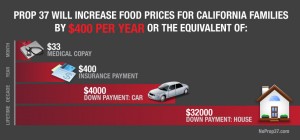Photo by Dodo-Bird.
This week I was tempted to review how the Hoefler and Frere-Jones slab-serif font addition to Gotham fared in Obama’s 2012 campaign design. Or if the Aquafresh-tinged logo of Romney’s brand made an impact on voters going to the polls, but last minute I decided to highlight a lesser-known important debate on the docket. (for those of you who geek out on design stuff like that, read more about the presidential candidates’ graphic design efforts and font choices here, here and here.) While Baltimore residents bundled up to cast their vote in the chilly November air, sunny Californians were weighing in on an issue that has the potential to dramatically change the burgeoning food movement in this country. If passed, Proposition 37 would require foods that are genetically engineered or modified to be labeled as such and they could no longer be labeled as “natural.” (Editor’s note: Proposition 37 was defeated 53.2% to 46.8%)
California has been the incubator of many of the grassroots food revolutions that have popularized the recent grub scene — think Alice Waters, Michael Pollan, the term locavore and eating in season. Prop 37 is in essence a battle between one of these small-scale local movements and the corporate giants that helped create them. Fifty other countries already require this type of food labeling.
Industrial-sized agribusiness companies including Monsanto, Dow and ConAgra spent over $40 million fighting the case, according to Dave Murphy, the co-chair of Prop 37, the California Right to Know Campaign and the founder and executive director of Food Democracy Now!. Most of these dollars are spent on advertising claiming the labeling effort would cause a sharp increase in food costs (gasp!). However, introduction of GMO labeling in Europe did not lead to any such rise and this study also refutes the claim.
Food package designs change quite frequently, whether to feature a new Wheaties spokesperson or gain a larger market share on grocery shelves. I hardly think the cost of the actual labeling is an issue. And wouldn’t it be the big guys’ financial responsibility?
We have a right to know where our food comes from and what is in it. Much like the labeling of trans fats and the introduction of the new Nutrition Facts label design in 1994 by D.C.-based design firm Greenfield Belser, designers are responsible for conveying information in plain language. No doubt, the transparency of the GMO label, no matter how straightforward, would skew buying behavior – chances are, not in favor of big agribusiness. Revealing indeed.



Science Magazine is doing a live chat tomorrow on GM foods: http://news.sciencemag.org/sciencenow/2012/11/live-chat-the-genes-we-eat.html